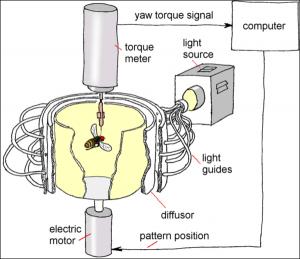 |
|
|
Do Fruit Flies Have Free Will?Science Daily — Free will and true spontaneity exist ... in fruit flies. This is what scientists report in a groundbreaking study in the May 16, 2007 issue of the open-access journal PLoS ONE.  The fly is flying stationarily in a cylindrical arena homogeneously illuminated from behind. The fly's tendency to perform left or right turns (yaw torque) is measured continuously and fed into the computer. In closed-loop, the computer controls arena rotation (single stripe or uniform texture as patterns on the arena wall). An additional white screen (not shown) covered the arena from above for all groups. (Credit: From Maye A, Hsieh C-h, Sugihara G, Brembs B (2007) Order in Spontaneous Behavior. PLoS ONE 2(5): e443. doi:10.1371/journal.pone.0000443) "Animals and especially insects are usually seen as complex robots which only respond to external stimuli," says senior author Björn Brembs from the Free University Berlin. They are assumed to be input-output devices. "When scientists observe animals responding differently even to the same external stimuli, they attribute this variability to random errors in a complex brain." Using a combination of automated behavior recording and sophisticated mathematical analyses, the international team of researchers showed for the first time that such variability cannot be due to simple random events but is generated spontaneously and non-randomly by the brain. These results caught computer scientist and lead author Alexander Maye from the University of Hamburg by surprise: "I would have never guessed that simple flies who otherwise keep bouncing off the same window have the capacity for nonrandom spontaneity if given the chance." The researchers tethered fruit flies (Drosophila melanogaster) in completely uniform white surroundings and recorded their turning behavior. In this setup, the flies do not receive any visual cues from the environment and since they are fixed in space, their turning attempts have no effect. Thus lacking any input, their behavior should resemble random noise, similar to a radio tuned between stations. However, the analysis showed that the temporal structure of fly behavior is very different from random noise. The researchers then tested a plethora of increasingly complex random computer models, all of which failed to adequately model fly behavior. Only after the team analyzed the fly behavior with methods developed by co-authors George Sugihara and Chih-hao Hsieh from the Scripps Institution of Oceanography at UC San Diego did they realize the origin of the fly's peculiar spontaneity. "We found that there must be an evolved function in the fly brain which leads to spontaneous variations in fly behavior" Sugihara said. "The results of our analysis indicate a mechanism which might be common to many other animals and could form the biological foundation for what we experience as free will". Our subjective notion of "Free Will" is an oxymoron: the term 'will' would not apply if our actions were completely random and it would not be 'free' if they were entirely determined. So if there is free will, it must be somewhere between chance and necessity - which is exactly where fly behavior comes to lie. "The question of whether or not we have free will appears to be posed the wrong way," says Brembs. "Instead, if we ask 'how close to free will are we"' one finds that this is precisely where humans and animals differ". The next step will be to use genetics to localize and understand the brain circuits responsible for the spontaneous behavior. This step could lead directly to the development of robots with the capacity for spontaneous nonrandom behavior and may help combating disorders leading to compromised spontaneous behavioral variability in humans such as depression, schizophrenia or obsessive compulsive disorder. The research will appear in the May 16, 2007 issue of the open-access journal PLoS ONE. Citation: Maye A, Hsieh C-h, Sugihara G, Brembs B (2007) Order in Spontaneous Behavior. PLoS ONE 2(5): e443. doi:10.1371/journal.pone.0000443 (http://www.plosone.org/doi/pone.0000443) Note: This story has been adapted from a news release issued by Public Library of Science. New! Search Science Daily or the entire web with Google: |
Health Videos & Features
Understanding the ADHD Racial Gap
Related News SectionsRelated News TopicsRelated Science StoriesRelated Encyclopedia ArticlesRelated Book Reviews |
Search Archives
In Other News ...Terror suspect alleges Guantanamo torture (2 hours ago) Somalia bomb kills 5 African peacekeepers (2 hours ago) Republicans show their conservative plumes (2 hours ago) Serbia installs pro-Western Cabinet (2 hours ago) Sarkozy sworn in as French president (2 hours ago) M.L. King's daughter Yolanda dead at 51 (2 hours ago) Bush names war czar (3 hours ago) Gunfire shatters latest Gaza truce (3 hours ago) Bolton: Don't let Iran build nuclear bomb (3 hours ago) Rockets hit Israel (3 hours ago) ... more breaking news at NewsDaily -- updated every 15 minutes |
|||||||||||||||||||||||